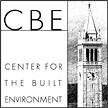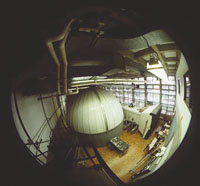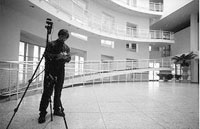

Center for the Built Environment (CBE)
University of California at Berkeley
A National Science Foundation Industry/University Cooperative Research Center since 1997
Innovative building technologies will improve the environmental quality, energy efficiency, and workplace productivity of commercial buildings

|
Center Mission and Rationale
Improving the quality of indoor environments and enhancing the energy performance of commercial buildings could lead to productivity gains and operating cost reductions worth hundreds of billions of dollars in the U.S. alone. Despite this huge potential, building research as a percentage of sales is well below that of other industries. In May 1997, a group of industry and government leaders teamed up with faculty and researchers at the University of California, Berkeley, to address the challenges of creating high-quality buildings. The result was the Center for the Built Environment (CBE), with the mission of providing timely, unbiased information on promising technologies and creating a dynamic, collaborative setting where people can develop ideas for improving the design and operation of commercial buildings.
Research Program
CBE conducts a variety of building research projects, ranging from the evaluation and development of new building technologies that reduce energy use, improve environmental quality, enhance occupant comfort, and increase productivity, to tools that "take the pulse" of buildings in operation, enabling everyone in the building process to learn how a building actually performs in practice.

|
Current and recent CBE research includes:
- Underfloor air distribution
- Individual control of the indoor environment
- Web-based occupant surveys of indoor environmental quality
- Benchmarks of building energy efficiency
- Operable windows in office buildings
- Impact of ventilation on workplace productivity
- Using occupant feedback to improve building operations
- Wireless sensor networks for improved building control
- Speech privacy in offices.
Since the building industry involves a mix of disciplines, professions, and physical processes, an interdisciplinary approach is essential. CBE draws upon the expertise of 15 faculty in six departments across the UC-Berkeley campus, as well as staff scientists at Lawrence Berkeley National Laboratory and full-time in-house research specialists. Fourteen students are currently assisting the Center in carrying out its research.
In addition to participating in the Industry/University Cooperative Research Centers Program, CBE researchers are active in the following:
- Modeling Human Comfort: detailed analytical model of human thermoregulatory physiology, matched to human subjective responses, capable of evaluating complex thermal environments
- Reducing Building Energy Use: projects ranging from alternatives to compressor-based air conditioners in housing, to energy rating tools for windows, to technology reviews for the Federal Energy Management Program
- Wind Tunnel and Solar Modeling: evaluation of the interaction of building design with wind, daylight, and other environmental influences
- Revising Thermal Comfort Standards: development of an alternative field-based standard for naturally ventilated buildings.

|
Special Center Activities
During the past two years, many of CBE's projects have produced significant results. The following projects have publicly disclosed findings:
- Supply Fan Energy Use in Pressurized Underfloor Air Distribution Systems: This study explored the impact of various design assumptions on the supply fan energy consumption of pressurized underfloor plenum systems, as compared to that of traditional overhead constant air volume and variable air volume systems.
- Team Spaces and Collaboration: Links to the Physical Environment: Team workspace is a specific type of alternative office design to support the activities of highly interactive, multi-disciplinary teams of knowledge workers. The design normally provides individual workspaces for private concentrated work, combined with nearby shared open spaces for group work. The move toward this combination of group and individual spaces is motivated by new work models that emphasize self-directed, team-based work processes and projects. CBE conducted a pilot survey of team workspace with the following objectives: (1) to study the impact of team workspace design on user satisfaction and group interaction, and (2) to test new survey methods and metrics for assessing the performance of team workspace.
- Mixed-Mode Office Buildings: Occupant Satisfaction and Control: Mixed-mode (MM) strategies have the potential to offer the best of all worlds by using natural ventilation to provide occupant control, high ventilation rates, and reduced HVAC energy while using air-conditioning to maintain comfort as necessary. A successful MM design will produce a cost-effective, comfortable, relatively low-energy building that can be easily adapted to changing building uses and HVAC load conditions. This case study project evaluated the successes and failures of three such buildings in California.
- Responding to Thermal Sensation Complaints in Buildings: This report describes a new strategy for managing thermal sensation complaints that occur when the building systems affecting thermal sensation are operating normally. Thermal sensation complaints of this type account for more than half of all thermal sensation complaints handled by facility management staff.
- Underfloor Air Supply Plenums: This report contains results of a field test of minimum effective plenum height. This report shows that very low-height plenums function effectively for underfloor air distribution.
- The Impact of Ventilation Control Methods on Productivity, Energy Use and Health: This report describes an analysis of worker performance at a hospital call center. The study found significant correlation between work performance and factors related to indoor environmental quality.
A core strength of CBE is that its membership mirrors the diversity of the building industry. All of CBE's members plan to use advances developed by CBE in their businesses.
Facilities
Most of CBE's facilities are housed at the UC-Berkeley College of Environmental Design. CBE's equipment and instrumentation includes a Controlled Environment Chamber, designed to resemble a contemporary office while allowing precise control over the temperature, humidity, ventilation, and lighting in the space; a Boundary Layer Wind Tunnel, which simulates the natural wind over models of the built environment in order to predict wind effects at full scale; a unique segmented thermal manikin for studying thermal comfort and environmental control provided by building systems; and an instrumented cart that makes detailed measurements of the physical environment from ankle level to head height. The Center also has a wide array of portable equipment for acquiring and analyzing data from experiments in the field as well as in the laboratory, including infrared thermographs, heat flux meters, flow metering hoods, tracer gas systems, flow visualization systems, electric power meters, instrumentation for measuring the detailed thermal and luminous characteristics of building interiors, and portable weather stations for measuring exterior microclimates. Shared and/or off-site facilities include a full-scale testbed underfloor air facility; sky simulators for modeling daylight in buildings (developed with Lawrence Berkeley National Laboratory with funding from the U.S. Department of Energy); and a large Heliodon with a collimated beam and a miniature point-of-view video camera for analyzing solar access and shading (developed with the Pacific Energy Center, San Francisco).
Center Headquarters
Center for the Built Environment
University of California-Berkeley
390 Wurster Hall #1839
Berkeley, CA 94720-1839
Tel (510) 642-4950 * Fax (510) 643-5571
Homepage: www.cbe.berkeley.edu
Center Director: Dr. Edward A. Arens
earens@uclink.berkeley.edu
Center Evaluator: Dr. Howard Levine
(510) 849-0358 * hlevine2@earthlink.net
NSF 01-168t